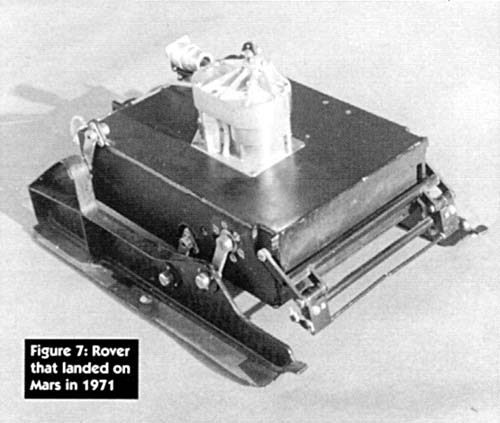The First Rover on Mars - The Soviets Did It in 1971

Written by
Charlene Anderson
August 1, 1990
The following is reprinted from the July/August 1990 issue of The Planetary Report.
Two robotic rovers reached the surface of Mars in 1971 during the Soviet Mars 2 and 3 missions, Dr. Alexander Kermurjian has revealed exclusively to The Planetary Report. Neither vehicle completed its mission: Mars 2 crash-landed on the planet and Mars 3 ceased transmissions 20 seconds after landing.
The presence of mobile vehicles on these missions had not been revealed for nearly 20 years. Previous descriptions of Mars 2 and 3 omitted mention of the small vehicles that were attached to the main landers by tethers. Their range was to be 15 meters from the lander. The rovers moved by using skis set on either side (see photograph). The two thin bars at the front of the lander (if you look closely at the photograph, you'll see the division between them) are sensors to detect obstacles in the rover's path. The vehicle could determine on which side the obstacle lay, step back, change direction and try to go around it. This rudimentary artificial intelligence was necessary for these martian rovers; signals from Earth to Mars can take between 4 and 20 minutes to reach their destination (see box, page 9) - too long for a walking robot to wait for commands from Earth. By the time an obstacle had been recognized by mission controllers and commands transmitted from Earth, a rover could have already fallen to its demise.

The Soviet rovers each carried two scientific instruments: a dynamic penetrometer and a densitometer. They were to measure the bearing strength and density of the soil. Although the Mars 2 and 3 landers failed, their accompanying orbiters both successfully completed their missions and returned useful data to Earth. Mars 2, although it crashed, holds the distinction of being the first human-made object to reach the surface of Mars. The landers had the misfortune to arrive during one of the greatest martian dust storms in recorded history. A prevalent explanation for the sudden loss of contact with Mars 3 is that the lander was blown over by the fierce martian wind.
Mars 2 and 3 was launched May 19, 1971 and reached the Red Planet on November 27. Mars 3 followed a few days later, launching on May 28 and landing on December 2. The orbiters continued their work until August 1972, when the Soviets declared the missions completed. The United States' Mariner 9 spacecraft had taken advantage of the same launch window (when the relative positions of Earth and Mars allow the quickest route between them). It launched on May 30 and entered orbit about Mars on November 14. Since its mission was strictly an orbital one, Mariner 9 was able to wait out the dust storm. When the dust cleared, it discovered the great volcanos of Tharsis, the layered polar terrain, ancient river valleys, the nature of seasonal change, and Valles Marineris, the might canyon complex now named for its robotic discoverer.
With Lunokhod 1 in 1970, the Soviet Union had become the first nation to land a rover on another world. In 1971 they almost succeeded in repeating their triumph with Mars 3.
Support our core enterprises
Your gift today will go far to help us close out the year strong and keep up our momentum in 2026.
Donate

 Explore Worlds
Explore Worlds Find Life
Find Life Defend Earth
Defend Earth

